[1] Like many boys my age, I spent most of the 1980s immersed in alternate worlds, each with its own arcana and mythology. Even now, their names sound like an evocation, a chant in exotic language that brings back the depth and detail of other universes. The words conjure memories for me of places visited in dreams, as Cair Paravel would sound to the Pevensie children returned from Narnia, of adventures in a different dimension—or dimensions, because I spent time in various fictional universes, each with its own geography. Dantooine, Hoth, and Alderaan from George Lucas; Termight, Nu Earth, and Mega-City One from 2000AD; Gethen, Whileaway, and Herland from feminist science fiction; Edoras, Isengard, and Lorien from Tolkien.
[2] There was another universe, its language and landmarks more obscure, more specialist. If your ears pricked at these names now, we would know each other as fellow travelers and would immediately recognize each other as part of that community. We could reminisce. See if they ring bells.
[3] Eidolon. Exolon. Earthlight. Fairlight. Fractalus.
[4] Those are the names of worlds—or adventures, missions, stories in those worlds—from 1980s computer games. Some were released on a range of home machines, but I played them primarily on the ZX Spectrum. The Spectrum was first sold in 1982 by Sinclair Research Limited. It had a one-channel speaker, and was launched with 16 kb of memory—15 kb more than its predecessor, the ZX81. Unlike the ZX81, it also displayed color, and hence the name. It displayed eight colors. Anyone who owned a ZX Spectrum could name those colors now, in another mantra from memory; and there is evocative magic in those names too; few 12-year-old boys would have encountered the word cyan before they found it on the Spectrum's key 5.
[5] It displayed eight colors, and this was the point: only eight colors, deployable as an "ink" foreground or "paper" background, on an eight-by-eight grid of pixels. As an evolution from the ZX81, this was a quantum leap, but the Spectrum's graphics were, by the standard of today's near-photorealism in games, severely limited. And this was the point. The titles above sound like a chant, almost like verse, and the worlds created on the Spectrum were poems, not photographs. They asked for your investment. They needed your imagination, your faith, your belief, to make them come to life. They invited you to help create worlds.

Figure 1. TLL, or Tornado Low-Level (Vortex, 1984).
[6] Figure 1 is a screenshot from TLL, or Tornado Low-Level, released by Vortex software in 1984. When I look at it, I'm surprised by how basic the graphics seem—not because gaming has moved on so dramatically, now that PS3 and Xbox titles are virtually indistinguishable from cinema, but because my memory of TLL is of the richer experience I read into the game, the world that the game implies and that I helped to imagine. I don't remember TLL in terms of moving a tiny black graphic of a plane up and down in forced perspective over blocks of crude color. My memories of the game involve swooping under bridges, skimming beaches, and buzzing the red roofs of neat white houses.
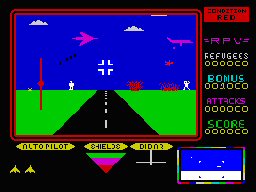
Figure 2. Zzoom (Imagine Software, 1983).
[7] Here's a similar example: Zzoom, released by Imagine Software in 1983 (figure 2). I don't remember Zzoom as a garish clutter of magenta airplanes and bright red tanks, like a kid's poster painting of a war zone. I remember the way palm trees rushed toward your windscreen in the desert zone, and the way, between attack waves, the camera drifted up into the clouds in a brief, calm interlude. In both cases, I remember landscapes, skies, seas, and natural environments rather than military hardware.
[8] The games were not photographs but poems; you had to do some of the interpretive work yourself. Or, to put it another way, they were not pictures of the fictional universe: they were maps. They were schematics. They offered a top-down diagram of a location—with symbols or simple shapes representing people, vehicles, and buildings—rather than a satellite image. They were a radar screen, with ciphers showing the location of obstacles and enemy, rather than the view from a cockpit. Playing the game was like flying on instruments only; what you saw on the screen was not intended to represent a fictional world as we experience our own. That world reached you through an interpreter, and it had to be decoded.
[9] The game offered a relationship with the player, an understanding, a deal. The deal was this: there is a real, rich world out there, which this game represents through a simplified interface. If you accepted the deal and immersed yourself in the game, you didn't see it as moving little graphics around a screen. You bought into the notion that the game was a go-between within your world and the other universe, that it was translating for you, back and forward.
[10] This deal went unspoken. It was, to use the phrase William Gibson coined in 1984, a consensual hallucination. It was subtly encouraged and supported by the media that surrounded these games. A surrounding visual and narrative discourse constantly and tacitly confirmed the idea of a rich fictional universe behind each game, which the technically limited graphics could only schematically imply. Each game was a basic translation, a diagrammatic representation of a world revealed more fully through paintings and stories, and indirectly through cinema.
[11] I say "through cinema" not only because a number of games adapted blockbuster films of the time, in a small-scale, cross-platform franchise—so that the little graphics were assumed to represent Rambo (Ocean Software, 1985) or Robocop (Ocean Software, 1988)—but also because two movies, released during the early years of the ZX Spectrum's rise, had popularized the idea that a game was simply the visible interface of a larger universe.
[12] Tron (Steven Lisberger, 1982) and The Last Starfighter (Nick Castle, 1984) offered gamers the flattering reassurance that they were not merely teenage hobbyists but trainee warriors, learning skills that could be transferred to a galactic war, or godlike, all-controlling "users," revered by the champions of an electronic world. Both films had the premise that arcade games were merely simulations of real combat in a parallel universe, that the on-screen schematics were just a guideline, a two-dimensional representation of three-dimensional CGI.
[13] This conceit was picked up and continued in the visual discourse of ZX Spectrum cover art. Some of the earliest ZX81 games featured box design as primitive as the screen display—one release from Artic Software was simply packaged as Adventure C in text as bare and plain as the game itself—but software companies soon adopted the convention of advertising a game with painted or airbrushed artwork in the style of science fiction and fantasy paperbacks. Everyone knew the game looked nothing like that, but the art enhanced and enriched the actual graphics by providing a vision of the world on the other side of the interface.
[14] The convention had been established by the earliest arcade machines of the 1970s, which surrounded the basic graphics of their screens with elaborate cabinet art. It was perpetuated by Atari's console ports of the same games, with even more primitive graphics and more lavishly painted console boxes. However, the ZX Spectrum, which published magazines that turned home gaming into a youth culture and lifestyle choice, played up the sense that every shoot-'em-up was a simulation of another world. One man in particular deserves the credit for this illusion: Oliver Frey, the house artist of Crash magazine.
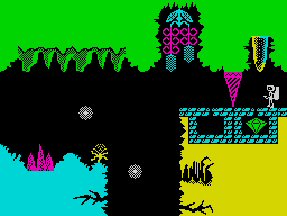
Figure 3. Backpackers' Guide to the Universe (Fantasy Software, 1984).
[15] Figure 3 is Backpackers' Guide to the Universe, published by Fantasy Software in 1984. The little white figure is Ziggy, who had appeared in two previous games (The Pyramid and Doomsday Castle) from the same company.
[16] Following convention, Backpackers' Guide was promoted through advertising and cover art that suggested a rich science fiction story-world behind the garish screen display. Its loading screen, which displayed while the game booted up from cassette, rendered the same artwork within the Spectrum's limited palette (figures 4 and 5).
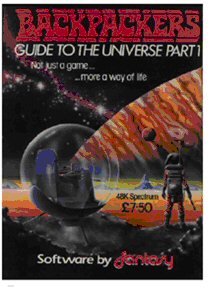
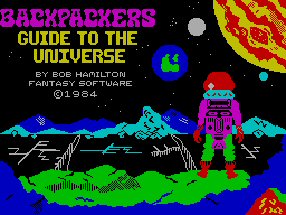
Figures 4 and 5. Backpackers' Guide to the Universe (Fantasy Software, 1984), as promoted through advertising and cover art, suggested a science fiction story world.
[17] Figure 6 shows the cover of Crash magazine from October 1984, previewing Backpackers' Guide. The painting, by Oliver Frey, goes further than the game's cover art. It makes Ziggy into a pop star. It imagines the details of his scarlet boots and monogrammed shoulder pads, his thigh-mounted control panel and inbuilt floodlight, his padded vinyl suit and floppy hair, like a science fiction front man from A-ha or Duran Duran (no surprise, in hindsight, that Frey was drawing gay sex comics during the same period).
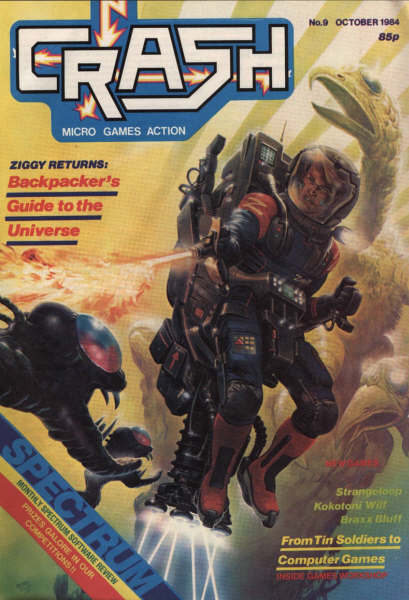
Figure 6. Cover of Crash magazine, October 1984, by Oliver Frey, previewing Backpackers' Guide. [View larger image.]
[18] Or rather, the painting imagines those details, but it implies that this is the real world of Ziggy and Backpackers' Guide, which eight-color graphics can only crudely represent. By moving the little white sprite on the screen, you guide this blond hunk's fantasy adventures. (In 1985, Ocean Software's game Frankie Goes to Hollywood literalized the idea of controlling pop stars through on-screen ciphers.)
[19] Finally, the worlds behind the game screens were elaborated through story. Just as the cover artwork of Spectrum software and magazines lifted its style from fantasy and science fiction paperbacks, so the inlay text—the fold-out information inside the cassette—borrowed from familiar science fictions and space operas. Each little plastic box would include a history in tiny font, a dense, evocative explanation of how you were called to be defending the Earth this time, the enemy you would be facing (the Seiddab, the Sept, the Bydo) and the equipment gifted to you (the Manta ship, the R-9a Arrowhead, the Cobra Mark III). The oversized package for Elite (Acornsoft, 1984) even included a novella, The Dark Wheel.
[20] Building on existing, familiar discourses—The Hitchhiker's Guide to the Galaxy had been broadcast on the BBC during 1981, and the original Star Wars trilogy was almost complete when the Spectrum was first released—and assisted by Tron's conceit of a game as the crude interface with an elaborate science fiction mission, programmers, designers, artists, and writers successfully created the illusion of an immersive game world based around a limited, primitive primary text and encouraged players to read something far fuller and richer into those basic graphics.
[21] It may not be surprising that blocky planetscapes and tiny spacemen could generate excitement. Even a nongamer can understand that Space Invaders, Defender, Scramble, and Centipede drew experts like Flynn from Tron into a zone of instant twitch reactions, a merging with the machine in a simulation of cosmic war. But recall my overriding memories of TLL and Zzoom, of drifting clouds and golden beaches rather than low-level aircraft and Exocet missiles. My sense of the worlds created on the ZX Spectrum is not of combat zones, but of exploring spaces and wandering through unfamiliar environments.
[22] One of the key features of Crash, generated at least in part by reader demand and fan submissions, was a central section where amateur gamers sent in their hand-drawn maps of sprawling caverns, forests, and cities: Sabre Wulf, Kokotoni Wilf, Marsport, Avalon. Computer games allowed teenage boys, whose everyday lives were regulated by the rules of school, the family home, and part-time jobs, whose lived geography was limited to walking distance and bus routes, to become not just warriors, but explorers; masters not just of galactic combat, but of landscape and metropolis (note 1).
[23] It's the landscape of games I remember more than anything, perhaps because, like the other kids at my school, I was a city boy, my environment made up of high streets and tower blocks. Sometimes my memories are of the strangest places, like locations in the backgrounds of action games, peripheral details that seemed to sketch an outside world. I mapped them onto places I'd seen in real life, beyond the city, and somehow they stood for what to me was an exotic countryside, the slightly scary thrill of wide spaces and open air, the excitement of vacation.

Figure 7. Green Beret (Konami, 1985).
[24] I vividly remember—it almost seems absurd now, looking at those minimal graphics—the trees from Konami's Green Beret (1985) (figure 7). I linked them in my mind with the forest surrounding the rock-climbing wall I'd visited once with friends of my dad. Those bare graphics were icons that stood for something more. They were invested with the image of twilight falling behind treetops, with the scent of pines.
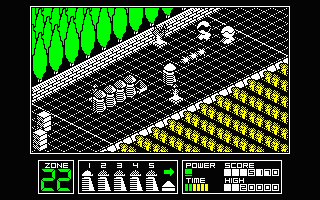
Figure 8. Highway Encounter (Vortex, 1985).
[25] And I remember this specific screen from Highway Encounter (Vortex, 1985) (figure 8). What I remember has nothing to do with the droids or the creatures. I remember instead the lines of roadside trees and crops. They are indelibly linked in my mind with another memory, of driving through France on a family holiday. The game recalled that strangeness, the slightly alien countryside, but importantly, it let me drive. It let me explore the road, and it gave me mastery and agency rather than a backseat view.
[26] ZX Spectrum games thrilled me, and they also scared me. Even now, 25 years later, I'd be reluctant to play Corridors of Genon (New Generation, 1983) and hear the monster's footsteps advancing behind me through a circular maze. But most of all, strangest of all, they felt melancholy. It was grown-up and liberating to move through worlds alone, but there was an overriding, and not entirely unpleasant, sense of loneliness about the exploration.
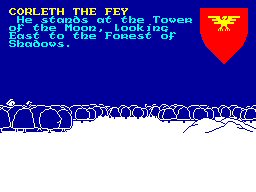

Figures 9 and 10. Lords of Midnight (Beyond, 1984) (left) and the paths of Tir Na Nog (Gargoyle, 1984) (right).
[27] Wandering the snowdrifts and blue-lit forests of Lords of Midnight (Beyond, 1984) (figure 9), or striding, solitary, down the paths of Tir Na Nog (Gargoyle, 1984) (figure 10), you were alone except for your enemies. You were independent, answerable to nobody, but you were also abandoned in a vast, hostile landscape, where a stranger on the same path almost always presented a threat rather than company.
[28] My experience of these games, then, while I engaged with them through the same interface as other players, is not quite the same as anyone else's. I invested my own memories and images into their templates and read the graphics through my understanding of "forest," or "mountains," or "beach," or "roadside," just as we all imagine characters and spaces in novels through our experience of places and people we know.
[29] Is this personalized, vivid investment in game space still possible now, with the photorealism of Grand Theft Auto IV? Nostalgia would say no, but as recently as Grand Theft Auto: San Andreas (Rockstar, 2004), I found that I could map my experiences of the simulated spaces—Los Santos, San Fierro, and Las Venturas—onto my memories of the real geography of Los Angeles, San Francisco, and Las Vegas. I could take special pleasure from admiring the sphinx of the Camel's Toe hotel, having visited the real-life Luxor, and looking up at the Big Pointy Building, remembering my own view of the Transamerica Pyramid. Increased realism may be no barrier to forming a personal connection with and immersion in video games. The medieval European village of Devil May Cry 2 (Capcom, 2003) reminds me of family holidays in Germany, just as the medieval European village of Nightshade (Ultimate, 1985) did almost 20 years before—but it does require less work, less imagination, and less investment.
[30] Grand Theft Auto provided a picture postcard of places I'd seen. The ZX Spectrum encouraged me and other boys to read, and help create, a kind of poetry.